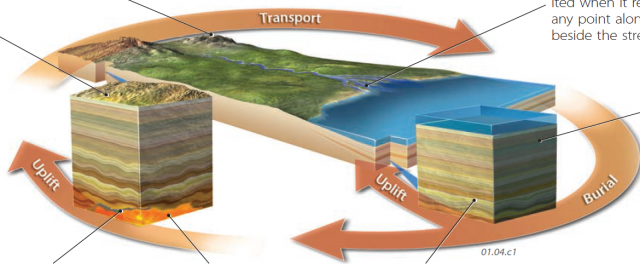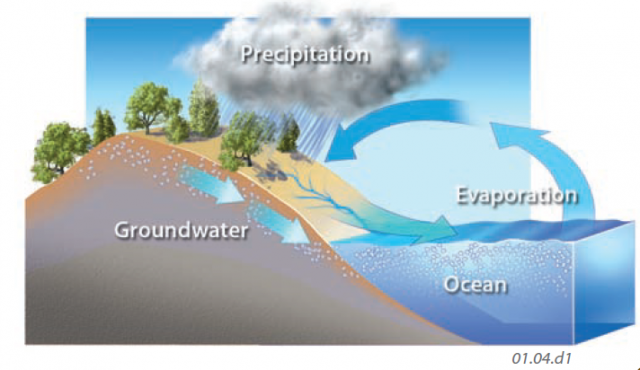What Are Some Important Earth Cycles?
MATTER AND ENERGY MOVE within and between each of the four spheres. A fundamental principle of all natural sciences is that energy and matter can be neither created nor destroyed, but only transferred from one form to another — the First Law of Thermodynamics. A second principle is that energy and matter tend to become dispersed into a more uniform spatial distribution — the Second Law of Thermodynamics. As a result, matter and energy are stored, moved, dispersed, and concentrated as part of natural cycles, where material and energy move back and forth among various sites within the four spheres.
What Is Cycled and Moved in the Atmosphere?
Atmospheric processes involve the redistribution of energy and matter from one part of the atmosphere to another. Moving air masses have momentum, which can be transferred from one object to another.
Energy

Storage and transfer of energy are the drivers of Earth's climate and weather. Energy can be moved from one part of the atmosphere to another, such as by air currents associated with storms. Also, energy is released or extracted from the local environment when water changes from one state of matter to another, such as from a liquid to a gas.
Matter

Water in all of its forms, along with other matter, moves globally, tending to disperse, but other factors prevent an even spatial distribution. As a result, some regions like here in the western U.S. are more humid and cloudy than others, as shown in this satellite image of water vapor (blue is more, brown is less). Also, water cycles between vapor, liquid, and solid states.
Momentum

Moving air masses have mass and velocity, so they have momentum, which is defined as mass times velocity. A dense, fast-moving dust storm has more momentum than a gentle breeze in dust-free air. Winds near the surface are slowed by interactions with trees, hills, buildings, etc. Winds aloft are faster and can transfer their momentum downward.
How Are Matter and Energy Moved in the Hydrosphere?
Many processes in the Earth occur as part of a cycle, a term that describes the movement of matter and energy between different sites in Earth's surface, subsurface, and atmosphere. The most important of these is the hydrologic cycle, which involves local-to-global-scale storage and circulation of water and associated energy near Earth's surface.
1. Water vapor in the atmosphere can form drops, which can remain suspended in the air as clouds or can fall to the ground as precipitation. Once on the surface, water can coat rocks and soils, and it causes these solids to decompose and erode.
2. When winter snows don't melt completely, as is common at higher elevations and at polar latitudes, ice accumulates in glaciers, which are huge, flowing fields of ice. Glaciers transport sediment and carve the underlying landscape.
3. Moving water on the surface can flow downhill in streams, encountering obstacles, like solid rock and loose debris. The flowing water and the material it carries breaks these obstacles apart and picks up and transports the pieces. Flowing water is the most important agent for sculpting Earth.
4. The uppermost part of oceans is constantly in motion, partly due to friction (and transfer of momentum) between winds in the atmosphere and the surface of the oceans. Winds in the oceans cause waves that erode and shape shorelines.
5. Water can sink into the ground and travel through cracks and other empty spaces in rocks and soils, becoming groundwater. Groundwater can react chemically with rocks through which it flows, dissolving or depositing material. It typically flows toward lower areas, where it may emerge back on Earth's surface as springs.
6. Water evaporates from the oceans, surface waters on land, and from soils and plants, returning to the atmosphere and completing the hydrologic cycle. Phase changes between a solid, liquid, and gas involve energy transformations.
How Does the Rock Cycle Affect Materials of the Lithosphere?
Matter and energy are also stored and moved on Earth's surface and subsurface. The rock cycle, summarized below and discussed in more detail later, describes the movement of matter and energy on and below Earth's surface at timescales from seconds to billions of years, involving such processes as erosion, burial, melting, and uplift of mountains.
- Weathering: Rock is broken apart or can be altered by chemical reactions when exposed to sunlight, rain, wind, plants, and animals. This weathering creates loose pieces of rock called sediment.
- Erosion and Transport: Sediment is then stripped away by erosion, and moved by gravity, glaciers, flowing water, or wind.
- Deposition: After transport, the sediment is laid down, or deposited when it reaches the sea or at any point along the way, such as beside the stream.
- Burial and Formation of Rock: Sediment is eventually buried, compacted by the weight of overlying sediment, and perhaps cemented together by chemicals in the water to form a harder rock.
- Deformation and Related Processes: Rock can be subjected to strong forces that squeeze, bend, and break the rock, causing it to deform. The rock might also be heated and deformed so much that it is changed into a new kind of rock.
- Melting: A rock exposed to high temperatures may melt and become molten, forming magma.
- Solidification: As magma cools, either at depth or after being erupted onto the surface, it begins to crystallize and solidify into rock.

What Cycles and Processes Are Important in the Biosphere?
The biosphere includes life and all of the places it exists. It overlaps the atmosphere, hydrosphere, and lithosphere, extending from more than 10 km above the surface to more than 10 km beneath sea level, both on the seafloor and within Earth's subsurface. Life interacts with the other three spheres, forming a number of important cycles, several of which are described later.
Plants exchange gases with the atmosphere. They extract carbon dioxide (CO2) from the atmosphere and use the carbon for their leaves, stems, roots, spines, and other leafy or woody parts. Plants also release oxygen, a key ingredient in life. Life on Earth is currently the main source of the oxygen and CO2 in the atmosphere.
Life interacts with the hydrologic cycle. Plants take in water from the rocks and soil, which may have arrived from lakes and other bodies of surface water, or directly from the atmosphere, as during precipitation. Plants then release some water back into the environment. The Sun is the ultimate source of energy for photosynthesis, as well as movement of matter and energy in the atmosphere and most movement of material on Earth's surface.

Life also interacts with aspects of the rock cycle. Plants help break down materials on Earth's surface, such as when a plant's roots push open fractures in rocks and soil. Plants help stabilize soils, inhibiting erosion, by slowing down the flow of water, allowing it to remain in contact with rocks and soil longer. This increases the rate at which weathering breaks down materials. Humans have altered the surface of Earth by removing vegetation that would compete with crops, villages, and cities.
Water, nutrients, and other materials are stored and cycled through the biosphere, at local to global scales. We use the term biogeochemical cycle to indicate that plants, animals, and bacteria, in addition to chemical and physical processes, are involved in the cycling of a chemical substance through different parts of the environment. For example, the movement of carbon between the biosphere, atmosphere, hydrosphere, and lithosphere is a biogeochemical cycle known as the carbon cycle.